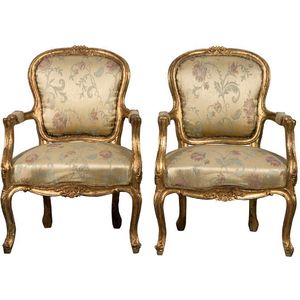Louis XVI Style Giltwood Fauteuil Chairs
You must be a subscriber, and be logged in to view price and dealer details.
Subscribe Now to view actual auction price for this item
When you subscribe, you have the option of setting the currency in which to display prices to $Au, $US, $NZ or Stg.
- Giltwood - Giltwood is used to describe a gold finish on furniture and other decorative wooden items, whereby a thin sheet of gold metal, called gold leaf, is applied to the surface for decorative purposes.
Unlike gilding, where the gold leaf is applied over a coating of gesso, with giltwood the gold leaf is applied direct to the surface, or over a coat of linseed oil gold leaf adhesive.
Most gold-finished mirrors will be gilded, whereas furniture with gold highlights will have the gold applied through the giltwood method. - Fluting - A form of decoration found on many pieces of furniture, as well as ceramics, silver and clocks, in which round-bottomed grooves, of varying width and depth, are let into columns, pilasters, legs. As a general rule, flutes are cut in the vertical, though they may follow a turned leg in a spiral pattern. In cross-section, they may be described as a series of 'U' shapes, rising and narrowing at each end of the groove. Fluting is the opposite of reeding, with which fluting is often associated.
- Scrolls - Serpentine-shaped forms, used in cabinet construction and decoration for centuries. The scroll appears in legs, feet, as carving in chair brackets, chair rails and arms. The deeper and more spontaneous the carving is, the earlier the piece is likely to be. The Regency or 'Thomas Hope' scroll, used on pediments and sideboard backs, consists of two scrolls on the horizontal plane, placed back to back in a mirror image, and sometimes decorated with a variety of carved and/or applied ornament, such as shells, foliate and other motifs. Chippendale-style furniture is often distinguished by two corresponding scrolls in the form of a 'C' in the upper splat or where chair legs join the seat rail.
- Acanthus - A stylized leaf motif, one of the primary decorative elements of classical Greek and Roman architecture, derived from the genus of flowering plants in the family Acanthaceae, native to tropical and subtropical regions of the Mediterranean area. It is a common element in classical Greek and Roman design, and is often seen in Corinthian and Composite order columns and used as a decorative element in English, European and Australian furniture, particularly on the curve of a leg, and as decoration for a corbel.
This item has been included into following indexes:
-
chairs, singles / pairs / threes, style or period
- fauteuils (arm chairs) 240
- French 949
- Louis XVI 186
Visually similar items

A pair of Louis XVI style carved giltwood fauteuils, 19th century, upholstered in blue silk damask

Pair of Louis XV style gilt wood fauteuils with floral moulded top rails, upholstered backs seats and arm rests in floral silks

A pair of gilt wood fauteuil in the Louis XVI style with tapestry covers 97 cm high, 72 cm wide

A colonial cedar reclining chair, circa 1840s, the tall reclining back with concave cedar top rail, upholstered in black horsehair and hinged to the similarly upholstered seat, the arms have horsehair rests and scrolling ends, turned front legs, the back l
